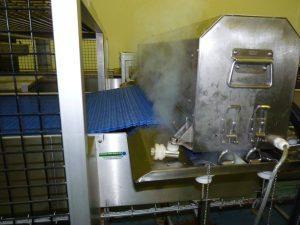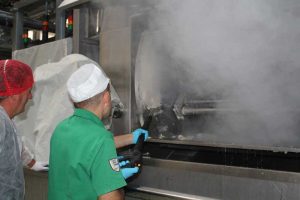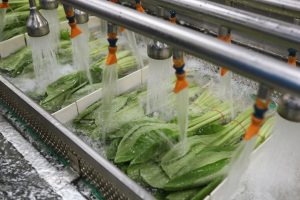Conveyor belt cleaning systems are an essential component of any industrial operation that utilises conveyor belts. These systems are designed to remove debris, spillage and other contaminants from the conveyor belt, ensuring that the belt remains clean and free from obstructions. The importance of conveyor belt cleaning systems cannot be overstated, as they play a crucial role in maintaining the efficiency and productivity of the entire conveyor system.
Firstly, conveyor belt cleaning systems help to prevent material build-up on the belt, which can lead to blockages and downtime. When materials such as coal, ore or grain accumulate on the belt, they can cause the belt to slip or become misaligned, resulting in costly production delays. By regularly cleaning the conveyor belt, these issues can be avoided, ensuring that materials can be transported smoothly and efficiently.
Moreover, conveyor belt cleaning systems also contribute to maintaining a safe working environment. A clean conveyor belt reduces the risk of accidents and injuries caused by slipping or tripping over debris. Additionally, by removing spillage and dust from the belt, the risk of fire hazards is also reduced, creating a safer workplace for employees.
Overall, the importance of conveyor belt cleaning systems lies in their ability to ensure the smooth operation of conveyor systems, prevent downtime and promote a safe working environment.
Summary
- Proper conveyor belt cleaning systems are important for maintaining a safe and efficient working environment in industries.
- There are various types of conveyor belt cleaning systems available, including scrapers, brushes, and air knives, each with its own advantages and applications.
- Using conveyor belt cleaning systems can lead to increased productivity, reduced maintenance costs, and improved workplace safety.
- When choosing a conveyor belt cleaning system, factors such as belt material, speed, and the type of material being conveyed should be considered.
- Regular maintenance and care for conveyor belt cleaning systems is essential to ensure optimal performance and longevity.
Types of Conveyor Belt Cleaning Systems
Common Types of Conveyor Belt Cleaning Systems
The most common types of conveyor belt cleaning systems include mechanical belt scrapers, belt brushes, and belt cleaners with water sprays.
Mechanical Belt Scrapers
Mechanical belt scrapers are one of the most widely used conveyor belt cleaning systems. These systems typically consist of a metal blade that is mounted at an angle to the belt and is designed to scrape off any material or debris that adheres to the belt surface. Mechanical belt scrapers are effective at removing stubborn materials such as sticky substances or large particles from the belt.
Belt Brushes and Water Sprays
Belt brushes are another type of conveyor belt cleaning system that is commonly used in industries where delicate materials or products are being transported. These systems use soft brushes to gently remove fine particles and dust from the belt surface without causing damage to the belt or the materials being transported. Belt brushes are often used in food processing and pharmaceutical industries where hygiene and product integrity are paramount. In addition to mechanical belt scrapers and belt brushes, there are also conveyor belt cleaning systems that incorporate water sprays to aid in the cleaning process. These systems use water jets to dislodge and wash away materials from the belt surface, providing a more thorough cleaning action. Conveyor belt cleaners with water sprays are often used in industries where the conveyed materials are particularly sticky or prone to adhering to the belt surface.
Benefits of Using Conveyor Belt Cleaning Systems

The use of conveyor belt cleaning systems offers a wide range of benefits for industrial operations. One of the primary benefits is improved operational efficiency. By keeping the conveyor belt clean and free from debris, the risk of blockages and downtime is significantly reduced, allowing for a smoother and more continuous flow of materials through the system.
This ultimately leads to increased productivity and cost savings for the operation. Another key benefit of using conveyor belt cleaning systems is improved safety. A clean conveyor belt reduces the risk of accidents and injuries caused by slipping or tripping over debris.
Additionally, by removing spillage and dust from the belt, the risk of fire hazards is also reduced, creating a safer working environment for employees. Furthermore, conveyor belt cleaning systems also contribute to prolonging the life of the conveyor belt itself. By preventing material build-up and reducing wear and tear on the belt surface, these systems help to extend the lifespan of the conveyor belt, reducing the need for frequent replacements and maintenance.
In addition to these benefits, using conveyor belt cleaning systems also helps to maintain product quality and integrity. By keeping the belt clean and free from contaminants, the risk of product contamination is minimised, ensuring that materials are transported in a hygienic and safe manner.
Factors to Consider When Choosing a Conveyor Belt Cleaning System
When selecting a conveyor belt cleaning system for a specific application, there are several factors that need to be taken into consideration to ensure that the system meets the requirements of the operation. One important factor to consider is the type of material being transported on the conveyor belt. Different materials may require different cleaning methods, so it is essential to choose a cleaning system that is suitable for the specific characteristics of the material.
The operating environment is another crucial factor to consider when choosing a conveyor belt cleaning system. Factors such as temperature, humidity, and the presence of corrosive substances can all impact the effectiveness and durability of a cleaning system. It is important to select a system that is designed to withstand the conditions present in the operating environment.
Additionally, the size and speed of the conveyor system should also be taken into account when choosing a cleaning system. Larger and faster conveyor systems may require more robust and efficient cleaning systems to ensure thorough and effective cleaning. The ease of installation and maintenance is another important consideration when selecting a conveyor belt cleaning system.
It is essential to choose a system that can be easily installed and maintained without causing significant disruptions to the operation. Finally, cost is also a significant factor when choosing a conveyor belt cleaning system. It is important to consider both the initial investment cost as well as ongoing maintenance and operational costs to ensure that the chosen system provides good value for money.
Proper Maintenance and Care for Conveyor Belt Cleaning Systems
Proper maintenance and care are essential for ensuring the continued effectiveness and longevity of conveyor belt cleaning systems. Regular maintenance helps to prevent issues such as wear and tear, component failure, and reduced cleaning performance. One important aspect of maintenance for conveyor belt cleaning systems is regular inspection.
Inspecting the system for signs of wear, damage, or misalignment can help to identify potential issues before they escalate into more significant problems. Regular inspections also provide an opportunity to clean and lubricate components as needed. In addition to regular inspections, it is essential to follow a scheduled maintenance routine for conveyor belt cleaning systems.
This may include tasks such as replacing worn or damaged components, adjusting tensioning mechanisms, and cleaning or replacing scraper blades or brushes as necessary. Proper care for conveyor belt cleaning systems also involves keeping them clean and free from debris. Accumulated material on the cleaning system can reduce its effectiveness and lead to premature wear.
Regularly removing debris from the system helps to maintain its performance and prolong its lifespan. Furthermore, it is important to follow manufacturer recommendations for maintenance and care specific to the type of conveyor belt cleaning system being used. This may include guidelines for lubrication, adjustment procedures, and recommended replacement intervals for components.
By following proper maintenance and care practices, industrial operations can ensure that their conveyor belt cleaning systems continue to operate effectively, contributing to improved productivity and safety.
Common Challenges and Solutions for Conveyor Belt Cleaning Systems

Common Challenges to Cleaning Performance
One common challenge is inadequate cleaning performance, which may be caused by factors such as worn scraper blades or brushes, incorrect tensioning, or ineffective water sprays. To address this challenge, regular inspections and maintenance are essential to identify and rectify issues that may be affecting the cleaning performance.
Component Wear and Tear
Another common challenge for conveyor belt cleaning systems is excessive wear on components such as scraper blades or brushes. This can be caused by factors such as abrasive materials or incorrect tensioning. To mitigate this challenge, it is important to select components that are designed for durability and wear resistance, as well as ensuring that tensioning mechanisms are correctly adjusted.
Material Build-up and Environmental Factors
In some cases, conveyor belt cleaning systems may also face challenges related to material build-up on components or within the system itself. This can lead to reduced cleaning performance and increased wear on components. Regular cleaning and maintenance can help to prevent material build-up and ensure that the system continues to operate effectively. Additionally, environmental factors such as temperature extremes or exposure to corrosive substances can also pose challenges for conveyor belt cleaning systems. Choosing components that are designed to withstand these conditions, as well as following recommended maintenance practices, can help to mitigate these challenges. Overall, by addressing common challenges through regular maintenance, proper component selection, and adherence to manufacturer guidelines, industrial operations can ensure that their conveyor belt cleaning systems continue to operate effectively.
Best Practices for Implementing Conveyor Belt Cleaning Systems
Implementing conveyor belt cleaning systems effectively requires careful planning and consideration of various factors. One best practice is to conduct a thorough assessment of the specific requirements of the operation before selecting a cleaning system. This includes considering factors such as material characteristics, operating environment, conveyor size and speed, as well as budget constraints.
Another best practice for implementing conveyor belt cleaning systems is to ensure proper installation by following manufacturer guidelines and recommendations. This includes correct positioning of components such as scraper blades or brushes, as well as appropriate tensioning of the system to ensure optimal cleaning performance. Regular training for personnel involved in operating and maintaining conveyor belt cleaning systems is also essential for effective implementation.
This helps to ensure that employees understand how to operate the system safely and efficiently, as well as how to perform routine maintenance tasks. Furthermore, ongoing monitoring and evaluation of the performance of conveyor belt cleaning systems is crucial for identifying any issues or areas for improvement. This may involve regular inspections, performance testing, and feedback from operators to ensure that the system continues to meet operational requirements.
Finally, it is important to establish a proactive maintenance schedule for conveyor belt cleaning systems to prevent issues before they occur. This includes regular inspections, component replacements as needed, and adherence to recommended maintenance practices provided by the manufacturer. By following these best practices for implementing conveyor belt cleaning systems, industrial operations can ensure that their systems operate effectively, contributing to improved productivity and safety in their facilities.
FAQs
What are conveyor belt cleaning systems?
Conveyor belt cleaning systems are equipment designed to remove debris, spillage, and other materials from conveyor belts to ensure a clean and safe operation.
Why are conveyor belt cleaning systems essential?
Conveyor belt cleaning systems are essential to maintain a clean and safe working environment, prevent material buildup, reduce the risk of accidents, and prolong the life of the conveyor belt.
What are the common types of conveyor belt cleaning systems?
Common types of conveyor belt cleaning systems include belt scrapers, belt brushes, belt cleaners, and air knife systems, each designed to effectively remove debris and spillage from the conveyor belt.
How do conveyor belt cleaning systems improve safety?
By removing debris and spillage, conveyor belt cleaning systems help prevent slip and fall accidents, reduce the risk of fire hazards, and ensure that the conveyor belt operates smoothly and efficiently.
What are the benefits of using conveyor belt cleaning systems?
The benefits of using conveyor belt cleaning systems include improved workplace safety, reduced maintenance costs, increased productivity, and extended conveyor belt life.
How often should conveyor belt cleaning systems be maintained?
Conveyor belt cleaning systems should be regularly inspected and maintained according to the manufacturer’s guidelines to ensure optimal performance and safety. Regular cleaning and inspection of the systems are also recommended.










